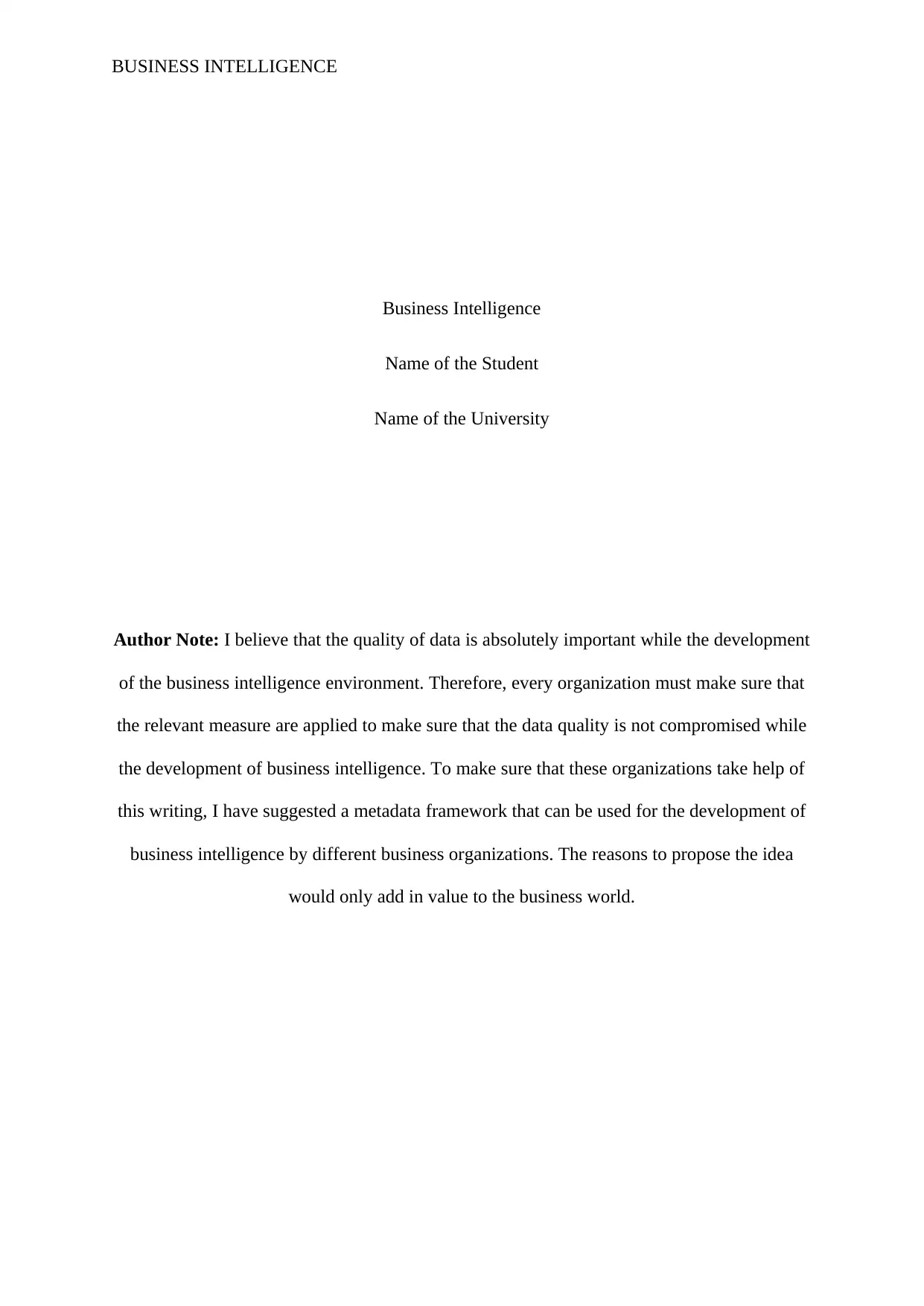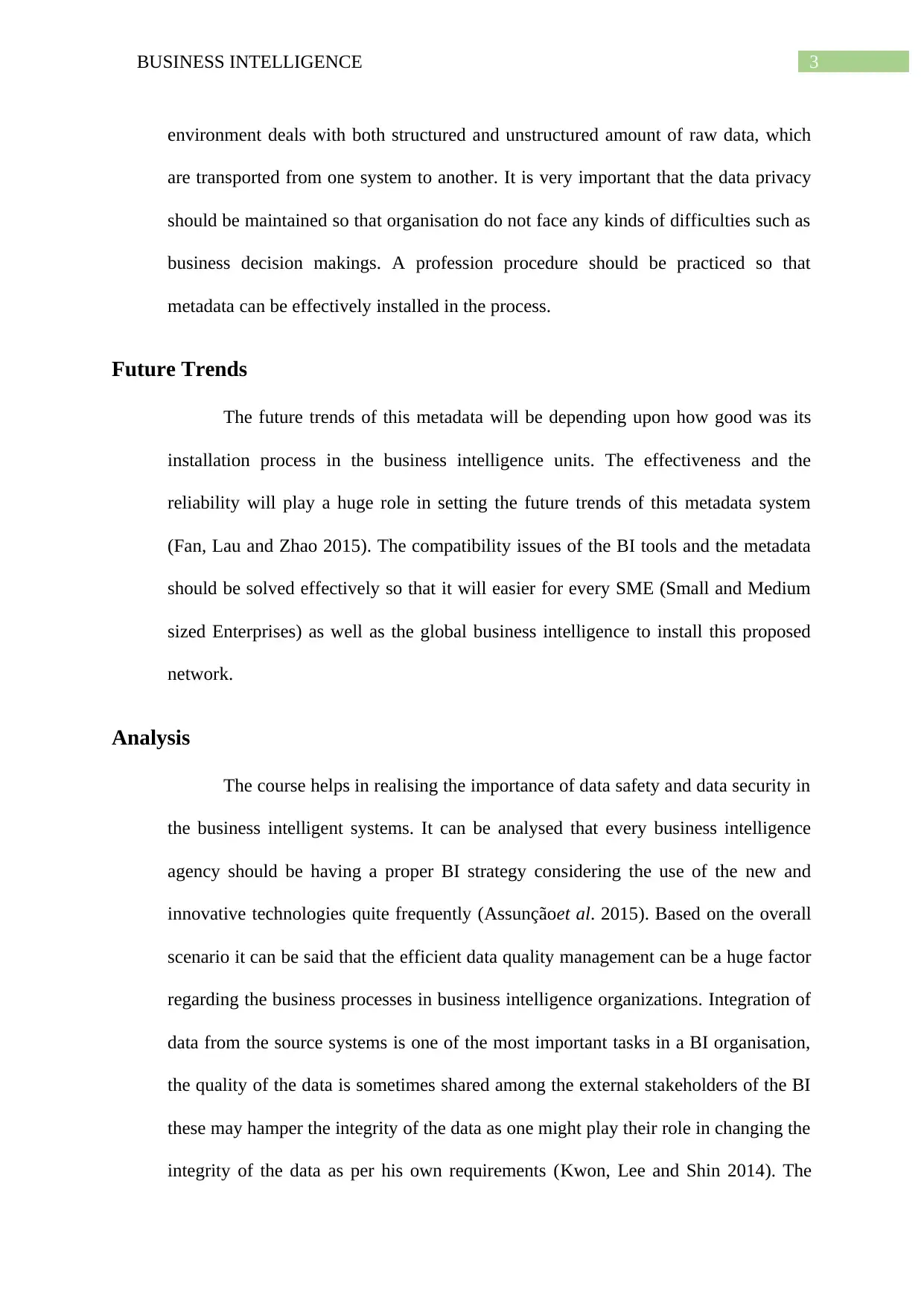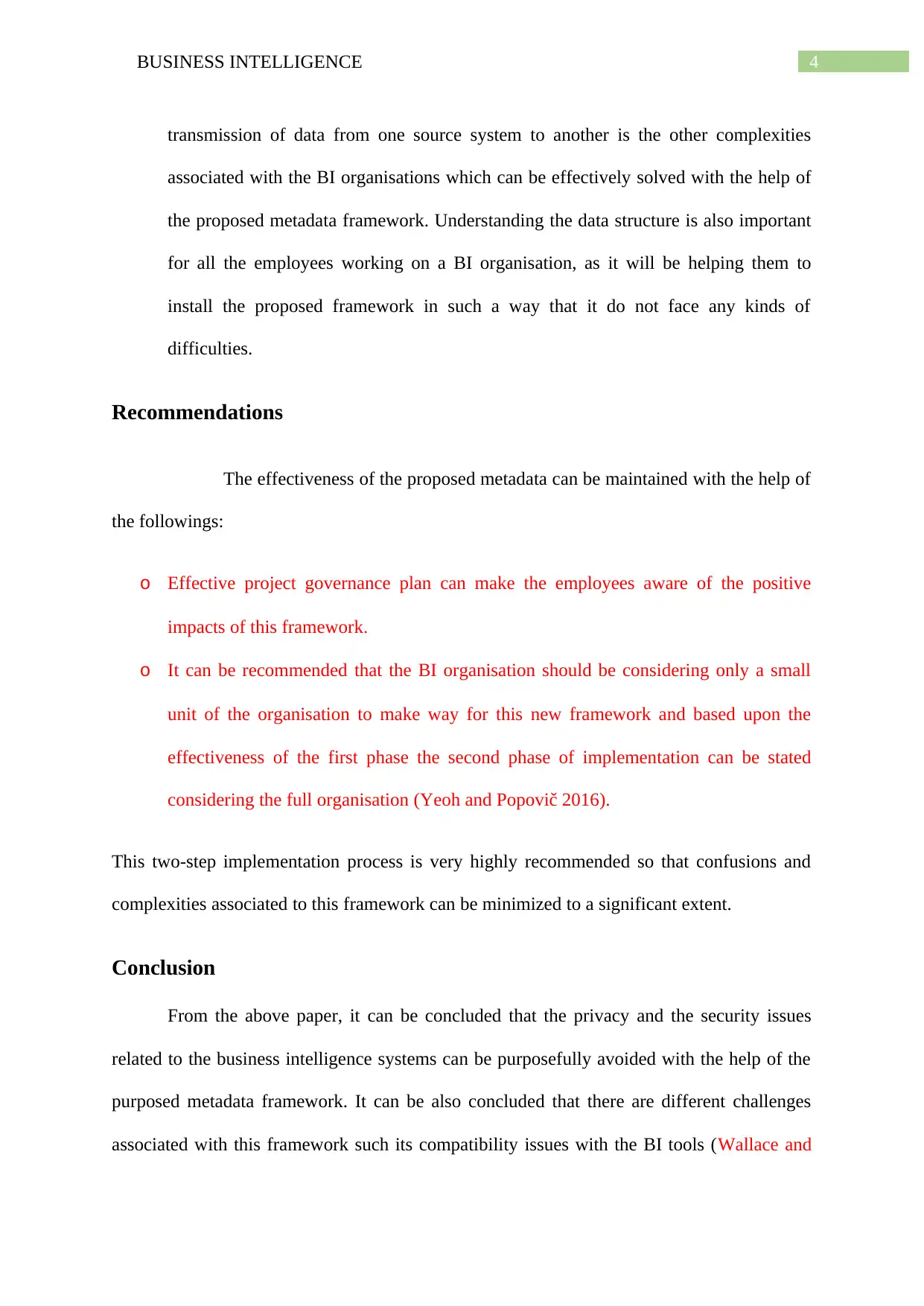Report on Data Quality Issues and Metadata Framework in BI Systems
VerifiedAdded on 2021/12/16
|7
|1299
|81
Report
AI Summary
This report delves into the critical importance of data quality within Business Intelligence (BI) environments, emphasizing the need for robust data management practices. It focuses on a proposed metadata framework designed to enhance data security and overall quality. The report outlines the challenges associated with implementing such a framework, including cyber security threats, training requirements, and organizational resistance. It also highlights best practices, such as effective governance plans and professional procedures for metadata installation. Furthermore, the report explores future trends, emphasizing the significance of compatibility between BI tools and the metadata system, particularly for SMEs. The analysis underscores the need for a well-defined BI strategy that incorporates new technologies and efficient data quality management. Recommendations include implementing a two-step implementation process to minimize complexities and ensure effective project governance. The conclusion reinforces the framework's potential to mitigate security issues and improve the reliability of BI systems.

BUSINESS INTELLIGENCE
Business Intelligence
Name of the Student
Name of the University
Author Note: I believe that the quality of data is absolutely important while the development
of the business intelligence environment. Therefore, every organization must make sure that
the relevant measure are applied to make sure that the data quality is not compromised while
the development of business intelligence. To make sure that these organizations take help of
this writing, I have suggested a metadata framework that can be used for the development of
business intelligence by different business organizations. The reasons to propose the idea
would only add in value to the business world.
Business Intelligence
Name of the Student
Name of the University
Author Note: I believe that the quality of data is absolutely important while the development
of the business intelligence environment. Therefore, every organization must make sure that
the relevant measure are applied to make sure that the data quality is not compromised while
the development of business intelligence. To make sure that these organizations take help of
this writing, I have suggested a metadata framework that can be used for the development of
business intelligence by different business organizations. The reasons to propose the idea
would only add in value to the business world.
Paraphrase This Document
Need a fresh take? Get an instant paraphrase of this document with our AI Paraphraser

1BUSINESS INTELLIGENCE
Table of Contents
Introduction................................................................................................................................2
Challenges..................................................................................................................................2
Best Practices.............................................................................................................................2
Future Trends.............................................................................................................................3
Analysis......................................................................................................................................3
Recommendations......................................................................................................................4
Conclusion..................................................................................................................................4
Reference....................................................................................................................................5
Table of Contents
Introduction................................................................................................................................2
Challenges..................................................................................................................................2
Best Practices.............................................................................................................................2
Future Trends.............................................................................................................................3
Analysis......................................................................................................................................3
Recommendations......................................................................................................................4
Conclusion..................................................................................................................................4
Reference....................................................................................................................................5

2BUSINESS INTELLIGENCE
Introduction
The foremost determination of this paper is to focus on an article which
considers the importance of the data quality issues in a business intelligence
environment (Wang, Verbitskiy, and Yeoh 2019). The selected article proposes a
metadata framework which can be actively used in every type of organisations which
deals with business intelligence. The importance of data security and data quality
management is highlighted in this paper. The stated framework has the capability to
be an emerging framework in the coming years.
Challenges
The prime challenges associated with the wide acceptability of this framework
is its reliability as the cyber criminals are also developing new and innovative tools
for the hampering the data security. The other type of challenges related to this
framework is the high end training required to understand the working principals of
this framework and also the BI reporting tools, as it will be helpful for its installation.
There are lots of complexities associated to the incorporation of this framework such
as the lack of pre-established goal of the organisation. The estimation issues related to
the change management is the other important challenge for the installation of this
framework in any business (Forsgren and Sabherwal 2015). The organizational
resistance is the final challenges that this framework might face before getting
installed in a business environment.
Best Practices
The discussed metadata framework needs an effective governance plan before
being installed in a business intelligence environment. Every business intelligence
Introduction
The foremost determination of this paper is to focus on an article which
considers the importance of the data quality issues in a business intelligence
environment (Wang, Verbitskiy, and Yeoh 2019). The selected article proposes a
metadata framework which can be actively used in every type of organisations which
deals with business intelligence. The importance of data security and data quality
management is highlighted in this paper. The stated framework has the capability to
be an emerging framework in the coming years.
Challenges
The prime challenges associated with the wide acceptability of this framework
is its reliability as the cyber criminals are also developing new and innovative tools
for the hampering the data security. The other type of challenges related to this
framework is the high end training required to understand the working principals of
this framework and also the BI reporting tools, as it will be helpful for its installation.
There are lots of complexities associated to the incorporation of this framework such
as the lack of pre-established goal of the organisation. The estimation issues related to
the change management is the other important challenge for the installation of this
framework in any business (Forsgren and Sabherwal 2015). The organizational
resistance is the final challenges that this framework might face before getting
installed in a business environment.
Best Practices
The discussed metadata framework needs an effective governance plan before
being installed in a business intelligence environment. Every business intelligence
⊘ This is a preview!⊘
Do you want full access?
Subscribe today to unlock all pages.

Trusted by 1+ million students worldwide

3BUSINESS INTELLIGENCE
environment deals with both structured and unstructured amount of raw data, which
are transported from one system to another. It is very important that the data privacy
should be maintained so that organisation do not face any kinds of difficulties such as
business decision makings. A profession procedure should be practiced so that
metadata can be effectively installed in the process.
Future Trends
The future trends of this metadata will be depending upon how good was its
installation process in the business intelligence units. The effectiveness and the
reliability will play a huge role in setting the future trends of this metadata system
(Fan, Lau and Zhao 2015). The compatibility issues of the BI tools and the metadata
should be solved effectively so that it will easier for every SME (Small and Medium
sized Enterprises) as well as the global business intelligence to install this proposed
network.
Analysis
The course helps in realising the importance of data safety and data security in
the business intelligent systems. It can be analysed that every business intelligence
agency should be having a proper BI strategy considering the use of the new and
innovative technologies quite frequently (Assunçãoet al. 2015). Based on the overall
scenario it can be said that the efficient data quality management can be a huge factor
regarding the business processes in business intelligence organizations. Integration of
data from the source systems is one of the most important tasks in a BI organisation,
the quality of the data is sometimes shared among the external stakeholders of the BI
these may hamper the integrity of the data as one might play their role in changing the
integrity of the data as per his own requirements (Kwon, Lee and Shin 2014). The
environment deals with both structured and unstructured amount of raw data, which
are transported from one system to another. It is very important that the data privacy
should be maintained so that organisation do not face any kinds of difficulties such as
business decision makings. A profession procedure should be practiced so that
metadata can be effectively installed in the process.
Future Trends
The future trends of this metadata will be depending upon how good was its
installation process in the business intelligence units. The effectiveness and the
reliability will play a huge role in setting the future trends of this metadata system
(Fan, Lau and Zhao 2015). The compatibility issues of the BI tools and the metadata
should be solved effectively so that it will easier for every SME (Small and Medium
sized Enterprises) as well as the global business intelligence to install this proposed
network.
Analysis
The course helps in realising the importance of data safety and data security in
the business intelligent systems. It can be analysed that every business intelligence
agency should be having a proper BI strategy considering the use of the new and
innovative technologies quite frequently (Assunçãoet al. 2015). Based on the overall
scenario it can be said that the efficient data quality management can be a huge factor
regarding the business processes in business intelligence organizations. Integration of
data from the source systems is one of the most important tasks in a BI organisation,
the quality of the data is sometimes shared among the external stakeholders of the BI
these may hamper the integrity of the data as one might play their role in changing the
integrity of the data as per his own requirements (Kwon, Lee and Shin 2014). The
Paraphrase This Document
Need a fresh take? Get an instant paraphrase of this document with our AI Paraphraser

4BUSINESS INTELLIGENCE
transmission of data from one source system to another is the other complexities
associated with the BI organisations which can be effectively solved with the help of
the proposed metadata framework. Understanding the data structure is also important
for all the employees working on a BI organisation, as it will be helping them to
install the proposed framework in such a way that it do not face any kinds of
difficulties.
Recommendations
The effectiveness of the proposed metadata can be maintained with the help of
the followings:
o Effective project governance plan can make the employees aware of the positive
impacts of this framework.
o It can be recommended that the BI organisation should be considering only a small
unit of the organisation to make way for this new framework and based upon the
effectiveness of the first phase the second phase of implementation can be stated
considering the full organisation (Yeoh and Popovič 2016).
This two-step implementation process is very highly recommended so that confusions and
complexities associated to this framework can be minimized to a significant extent.
Conclusion
From the above paper, it can be concluded that the privacy and the security issues
related to the business intelligence systems can be purposefully avoided with the help of the
purposed metadata framework. It can be also concluded that there are different challenges
associated with this framework such its compatibility issues with the BI tools (Wallace and
transmission of data from one source system to another is the other complexities
associated with the BI organisations which can be effectively solved with the help of
the proposed metadata framework. Understanding the data structure is also important
for all the employees working on a BI organisation, as it will be helping them to
install the proposed framework in such a way that it do not face any kinds of
difficulties.
Recommendations
The effectiveness of the proposed metadata can be maintained with the help of
the followings:
o Effective project governance plan can make the employees aware of the positive
impacts of this framework.
o It can be recommended that the BI organisation should be considering only a small
unit of the organisation to make way for this new framework and based upon the
effectiveness of the first phase the second phase of implementation can be stated
considering the full organisation (Yeoh and Popovič 2016).
This two-step implementation process is very highly recommended so that confusions and
complexities associated to this framework can be minimized to a significant extent.
Conclusion
From the above paper, it can be concluded that the privacy and the security issues
related to the business intelligence systems can be purposefully avoided with the help of the
purposed metadata framework. It can be also concluded that there are different challenges
associated with this framework such its compatibility issues with the BI tools (Wallace and

5BUSINESS INTELLIGENCE
Webber 2017). It can be also determined that an effective implementation strategy should be
adopted by every BI who plans to install this framework on their system. The effectiveness of
the framework will be determining the future trends of this business. The framework can be
very much effective if it follows the two-step implementation process as discussed in the
recommendation unit of this paper.
Reference
Assunção, M.D., Calheiros, R.N., Bianchi, S., Netto, M.A. and Buyya, R., 2015. Big Data
computing and clouds: Trends and future directions. Journal of Parallel and Distributed
Computing, 79, pp.3-15.
Fan, S., Lau, R.Y. and Zhao, J.L., 2015. Demystifying big data analytics for business
intelligence through the lens of marketing mix. Big Data Research, 2(1), pp.28-32.
Forsgren, N. and Sabherwal, R., 2015. Business Intelligence System Use as Levers of Control
and Organizational Capabilities: Effects on Internal and Competitive Benefits.
Kwon, O., Lee, N. and Shin, B., 2014. Data quality management, data usage experience and
acquisition intention of big data analytics. International Journal of Information Management,
34(3), pp.387-394.
Wang, T.W., Verbitskiy, Y. and Yeoh, W., 2019. Depicting Data Quality Issues in Business
Intelligence Environment through a Metadata Framework. In Applying Business Intelligence
Initiatives in Healthcare and Organizational Settings (pp. 291-304). IGI Global.
Yeoh, W. and Popovič, A., 2016. Extending the understanding of critical success factors for
implementing business intelligence systems. Journal of the Association for Information
Science and Technology, 67(1), pp.134-147.
Webber 2017). It can be also determined that an effective implementation strategy should be
adopted by every BI who plans to install this framework on their system. The effectiveness of
the framework will be determining the future trends of this business. The framework can be
very much effective if it follows the two-step implementation process as discussed in the
recommendation unit of this paper.
Reference
Assunção, M.D., Calheiros, R.N., Bianchi, S., Netto, M.A. and Buyya, R., 2015. Big Data
computing and clouds: Trends and future directions. Journal of Parallel and Distributed
Computing, 79, pp.3-15.
Fan, S., Lau, R.Y. and Zhao, J.L., 2015. Demystifying big data analytics for business
intelligence through the lens of marketing mix. Big Data Research, 2(1), pp.28-32.
Forsgren, N. and Sabherwal, R., 2015. Business Intelligence System Use as Levers of Control
and Organizational Capabilities: Effects on Internal and Competitive Benefits.
Kwon, O., Lee, N. and Shin, B., 2014. Data quality management, data usage experience and
acquisition intention of big data analytics. International Journal of Information Management,
34(3), pp.387-394.
Wang, T.W., Verbitskiy, Y. and Yeoh, W., 2019. Depicting Data Quality Issues in Business
Intelligence Environment through a Metadata Framework. In Applying Business Intelligence
Initiatives in Healthcare and Organizational Settings (pp. 291-304). IGI Global.
Yeoh, W. and Popovič, A., 2016. Extending the understanding of critical success factors for
implementing business intelligence systems. Journal of the Association for Information
Science and Technology, 67(1), pp.134-147.
⊘ This is a preview!⊘
Do you want full access?
Subscribe today to unlock all pages.

Trusted by 1+ million students worldwide

6BUSINESS INTELLIGENCE
Wallace, M. and Webber, L., 2017. The disaster recovery handbook: A step-by-step plan to
ensure business continuity and protect vital operations, facilities, and assets. Amacom.
Wallace, M. and Webber, L., 2017. The disaster recovery handbook: A step-by-step plan to
ensure business continuity and protect vital operations, facilities, and assets. Amacom.
1 out of 7
Related Documents
Your All-in-One AI-Powered Toolkit for Academic Success.
+13062052269
info@desklib.com
Available 24*7 on WhatsApp / Email
![[object Object]](/_next/static/media/star-bottom.7253800d.svg)
Unlock your academic potential
Copyright © 2020–2025 A2Z Services. All Rights Reserved. Developed and managed by ZUCOL.





